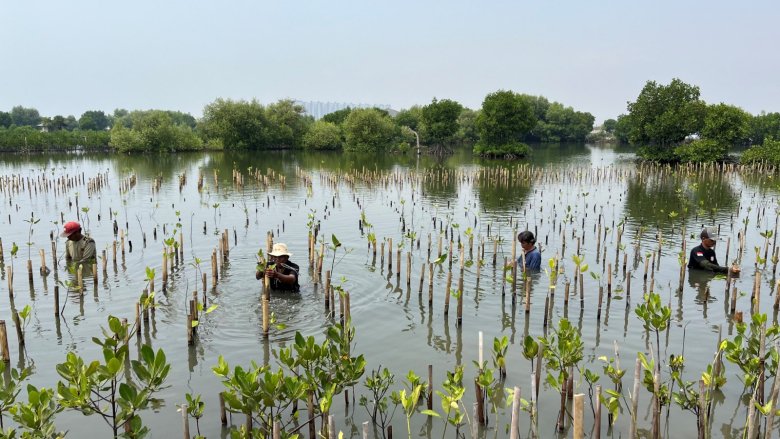Mangroves play a critical role in supporting coastal livelihoods, protecting coasts from disasters, and mitigating global climate change. They can contribute to ending poverty and creating a livable planet. They are particularly important in Indonesia, which has the world’s largest and most diverse mangrove forests.
Recognizing the critical value and ecosystem functions of its mangrove ecosystems, the government of Indonesia has incentivized local communities to plant mangroves, and the World Bank Mangroves for Coastal Resilience program will support scaling this effort up. The program aims to create new sources of income from participants, empower women, increase the profits of fisheries, and protect coastal areas from flooding. Conservation of healthy mangroves ecosystems and replanting are critical if Indonesia is to realize its ambitious plans to convert forests and other types of land into carbon sinks by 2030.
Indonesia is home to the largest and most diverse mangrove ecosystems in the world. They are critical because they support coastal livelihoods through fisheries (fish, crab, and other seafood); protect the country’s coasts from disasters; and store an estimated 3.14 billion tons of carbon dioxide, equivalent to the greenhouse gas emissions produced by approximately 2.5 billion vehicles driven for one year, thereby playing a significant role in mitigating global climate change. Mangroves store considerably more carbon than other species of trees.
Mangroves near developed coastal areas are worth about $50,000 a hectare, thanks to the role they play in flood protection. Despite their value, these forests are regularly lost and converted to other uses, including aquaculture, agriculture, and infrastructure (including for housing and tourism). Their loss increases the risk of events such as flooding, erosion, and storms to people living in coastal areas. It also reduces the productivity of fisheries, reduces biodiversity (particularly species depending on mangroves as a habitat such as fish, crab, and other seafood), and increases greenhouse gas emissions. In fact, based on a recently published study, Indonesia has the potential to develop mangrove based blue carbon projects with a net present value of $532 million, reducing up to 11 million tons of carbon dioxide a year.

Mangroves, both newly planted and fully grown, in a mangrove park, north Jakarta. Photo: World Bank
Mangroves can be recovered, but the cost of doing so is high ($1,640–$3,900 per hectare in Indonesia), and efforts in other countries have often failed. About half of Indonesia’s mangroves – 1.82 million hectares – are “high quality” with no or minimal degradation. The remaining 1.58 million hectares of degraded mangroves (that is, mangroves partially converted to other land uses such as aquaculture ponds) provide an important opportunity for rehabilitation.
Indonesia has implemented various conservations efforts, including the Mangrove One Map, which maps the extent and quality of mangroves throughout the country. In 2021, the Environment and Forestry Ministry issued an official guideline on mangrove management that involves community participation.
These efforts could be complemented by strengthening the overarching policy on mangrove management and incorporating mangrove zoning into spatial planning, including for coastal infrastructure. The government could also expand the scope of its moratorium on issuing licenses to convert primary forest and peatlands to include all types of mangroves.

Nini has been planting mangroves at government’s site since 2021, which provides her with a steady income. Photo: Ebe/World Bank
Community participation is critical in mangroves' conservation and restoration, and since 2021 the Indonesian government has been paying people to grow mangroves. The program has changed the lives of many locals.
“The payment is enough to support my family,” said one grower, Mrs. Nini. “I can buy rice and groceries. I am grateful for this job. My friend and I plant mangroves together, and we have fun doing it. This program helps our community.”



